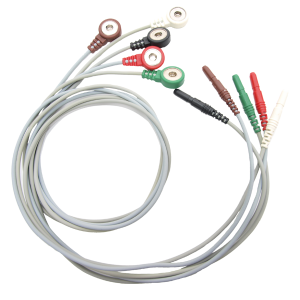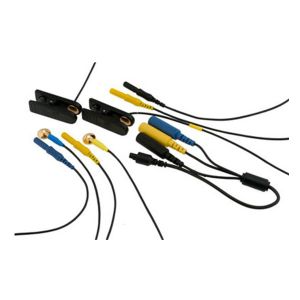We use cookies to make your experience better. To comply with the new e-Privacy directive, we need to ask for your consent to set the cookies. Learn more.
Accessories
- DIN EKG/EMG/EEG Snap Leads - 60 inchEMG/EEG/ECG leads, features MedSafe 1.5mm (.060) DIN connectors with snap style receptacles. 60 inch length leads, 3 per package. Black, Blue, Yellow. Learn More$35.00 As low as $24.50
- DIN EKG/EMG/EEG Snap Leads - 60 inch - 5 Lead KitEMG/EEG/ECG leads, features MedSafe 1.5mm (.060) DIN connectors with snap style receptacles. 60 inch length leads, 5 per package. AHA/ AAMI standard colors for 5 lead placement. Colors Red, Black, White, Green and Brown. Learn More$45.00 As low as $31.50
- Used EMG Sensor for FlexComp/MyotracThe used SA9503M surface EMG sensor consists of a triangular shape sensor head (SA9503M) with 3 snap style receptacles representing 2 active (positive & negative) electrodes and 1 reference (ground) electrode. Learn More$150.00
- Monopolar / Bipolar EEG Electrode Kit - Thought TechnologyThe T8750 EEG Electrode kit has DIN style EEG leads with DIN cable for the Thought Technology EEG Sensors. Includes cables for both Monopolar and Bipolar EEG placements. Includes (2) Gold Ear Clips and (2) Cup sensors - 22.5" in length and T8740 DIN Cable. Learn More$210.00
- Neuro100: BCIA Neurofeedback Certification Web ReviewThe Neuro100 web based service allows you to take 20-question multiple-choice exams and receive immediate feedback on your performance. All you need to use Neurofeedback100 is a web browser and an internet connection. Use of the site good for 1 year after purchase. Learn More$125.00
- Physiological Psychology Online Didactic CourseThe Physiological Psychology online didactic course fulfills BCIA’s Human Anatomy and Physiology requirement for neurofeedback certification. Once purchased you will receive access with 1-2 business days. Learn More$150.00
- Human Physiology Online CourseHuman Physiology satisfies BCIA's anatomy and physiology requirement for biofeedback certification or provides 45 hours of biofeedback recertification credit. Learn More$150.00
- Psychopharmacology Online CourseThis self-paced BCIA-accredited Psychopharmacology online didactic course for Biofeedback and Neurofeedback professionals. This course may be used to satisfy 45 of 48 hours of continuing education for Biofeedback or Neurofeedback recertification. Learn More$150.00
- Switch Sensor Cable for ProComp 2 with EEG-Z SensorThe switch sensor cable enables you to trigger an impedance check with the EEG-Z sensor by pressing and releasing the switch button to briefly interrupt the sensor circuit. The EEG-Z sensor enters impedance checking mode, without requiring you to disconnect and reconnect the sensor. Learn More$60.00
- Used T9305M Infiniti EEG SensorEEG Sensor for use with Thought Technology Procomp Infiniti, Procomp+ or Procomp 2. Learn More$150.00











